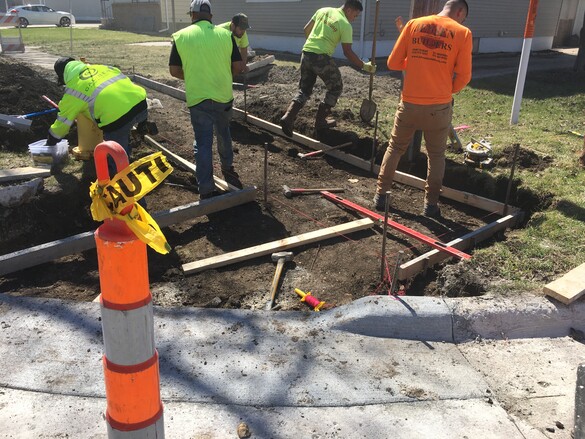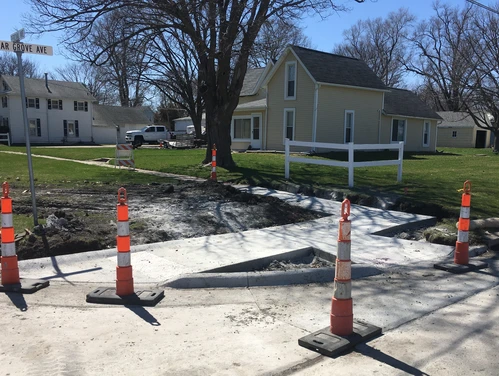In today’s world, we often take sidewalks for granted. They’re always under our feet, playing a vital role to connect our communities for walking, running, and bicycling. Well-designed sidewalks with features such as curb ramps and raised detectable warning surfaces ensure accessibility for all pedestrians
Sidewalks are more common in urban areas, but it’s not so easy for small towns with fewer municipal resources to make them available. The Iowa DOT prioritizes accessibility of the state’s transportation system for all who use it. This includes the need to have sidewalks and driveways adjoining state highways be accessible to people with disabilities.
As part of the Americans with Disabilities Act of 1990 (ADA) mandate, government entities like the Iowa DOT who receive federal funding must plan and update pedestrian access. As a result, the agency shares responsibility with cities for state highways, and it supports smaller communities (under 5,000 residents) to make accessibility planning and construction possible.
“We’re helping small communities get back to accessibility compliance where sidewalks and driveways exist in the state’s right of way,” says Iowa DOT ADA Design Coordinator Mike Ross of the program that operates out of the Design Bureau. “A sidewalk is an asset to our state highway, and it’s definitely an asset to the community, but if people cannot navigate that sidewalk because they can’t step up or roll a motorized chair, wheelchair, or walker over a curb, then it’s not accessible to everyone. That’s where we come in,” Ross adds.
Iowa DOT Launches ADA Transition Plan
Ross has been leading the Iowa DOT ADA compliance effort since 2011. In February 2012, the Iowa DOT adopted a plan to address ADA compliance along state highways in smaller cities. The plan identifies the steps the Iowa DOT will take to achieve ADA compliance for sidewalks and multiuse paths and ensures that all sidewalks and paths constructed meet guidelines established by the United States Access Board.
Working with staff from the Statewide Urban Design and Specifications (SUDAS) and Federal Highway Administration (FHWA), Ross worked in developing design guidance that used by all government agencies in Iowa.
Celebrating Service To 100 Communities and Counting
Along with team members Roger Larsen and Tom Bowman, Ross says the program recently celebrated an important anniversary. Projects with sidewalks and driveways in Griswold, Postville, Luxemburg, Hopkinton, Delhi and Dunlap, were recently completed in 2024 marking one of the program’s 100th community to become compliant.
“We’re very proud of this milestone, and excited to be a part of a program that’s been able to assist so many communities over the years. In every town, there are always people who aren’t sure the projects are necessary and don’t want us changing their sidewalks, but when we’re done, they’re believers,” Ross says.

Currently, projects are being constructed around state highway upgrades in Audobon, Chariton, Kimballton, Larchwood, Osage, Sheldon and Wellman. And there are hundreds more Iowa cities and towns that meet the criteria in the program that averages seven construction projects a year.
Once the ADA compliance team completes site visits, develops a construction plan for a community and confirms the contractors, Ross holds a public information meeting to introduce the projects to the community. The process allows the team to explain to residents the purpose and order of construction steps, talk through the timeline, and discuss proper ramp slopes and meeting other compliance standards.
“We try to help the public understand that there are rules we must follow. Sometimes, cities and towns themselves don't even know what those rules are,” says Ross.

Ross suggests that residents who want to understand why the DOT’s work is necessary to support a state highway can gain an understanding on the website’s Frequently Asked Questions. One of the most common questions is, ‘why does this work even need to be done?’
Ross says sidewalks and paths that do not meet guidelines established by the United States Access Board need to be replaced. Most sidewalks do not meet the guideline that only allows for a 2% maximum cross slope, which means with a sidewalk that is 5 feet wide, the difference from one side of the sidewalk to the other is only 1.25 inches.
“These projects have a cadence because the most area we can have torn up and under construction at any single time is four blocks,” says Ross. We start in the spring and summer, and we shoot to have them finished in August because is still gives us a seeding window to get grass growing and mowable again by fall and be able to close out the project over the wintertime.”
Ross says the program’s value comes full circle every time. “When somebody pulls up and unloads their wheelchair or gets out with a walker to use one of these ADA sidewalks, you can see right away that this person is now going to be able to get around easier. Enriching their lives with these improvements is why we do this work.”
